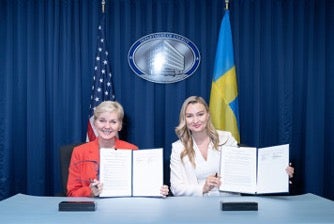
Sweden and the US have entered into a new agreement to further the development of new nuclear power. Sweden’s Minister for Energy, Business & Industry, Ebba Busch, has signed a memorandum of understanding (MOU) on bilateral nuclear cooperation in Washington DC with US Secretary of Energy Jennifer Granholm. The agreement aims to strengthen cooperation to support the development of new nuclear power.
The MOU means that Sweden and the US will exchange experience on issues related to policy, research and innovation related to supply chains, financing models, skills supply and development of advanced nuclear fuel. Cooperative activities are intended to start upon signature and may continue for ten years.
“This is good for Sweden, the United States, the labour market and competitiveness,” said Busch. “Our countries enjoy long-standing and good relations and I look forward to strengthening our cooperation and knowledge exchange in the area of nuclear power.”
“Today’s agreement further strengthens US cooperation with Sweden to diversify our supply chains and nuclear fuel supply, deploy new reactors, and find solutions to the management of our spent nuclear fuel,” Granholm said in a post on X.
The purpose of the MOU “is to provide a framework for the Participants to enhance overall cooperation between their respective government bodies, enterprises, and research institutions in policies and research and development activities relating to civil nuclear energy.” Areas of co-operation may include, but are not limited to various technology areas including:
- Nuclear power reactors, including advanced reactors such as small modular reactors (SMRs);
- Advanced nuclear fuel development;
- Nuclear waste management;
- Nuclear safety and security;
- Integration of nuclear in a zero-carbon electricity system; and
- Other relevant nuclear energy technologies that may be decided.
Areas of co-operation include;
- Nuclear regulatory framework;
- Nuclear waste management;
- SMR regulatory harmonisation;
- Supply chain and diversification of supply;
- Economic and financial frameworks;
- Human resources and workforce development;
- Trade promotion;
- Knowledge management methodologies;
- Multilateral cooperation on nuclear energy;
- Best practices and lessons learned for engaging the public on nuclear technology; and
- Sharing strategies for facility siting, including public participation aspects.
Sweden’s six nuclear power reactors provide about 40% of its electricity. In 1980, the government decided to phase out nuclear power, but parliament repealed this policy in 2010. The 1997 energy policy allowed 10 reactors to operate longer than envisaged in the phase-out policy, but nevertheless resulted in the premature closure of the two-unit Barsebäck NPP. In 2015, decisions were also made to close four older reactors by 2020 and Ringhals 1&2 were closed at the end of 2020 and 2019, several years earlier than planned in face of punitive taxes.
In October 2022, Sweden’s new centre-right coalition government adopted a positive position on nuclear energy, with the Christian Democrats, the Liberals, the Moderates and the Sweden Democrats issuing a written agreement known as the Tidö Agreement. It said energy policy was “changed from 100% renewable to 100% fossil-free”.
This was followed in January 2023 year by a formal proposal to cancel the current law limiting to 10 the number of reactors in operation, as well as to allow reactors to be built on new sites, rather than only on existing sites. The government introduced the bill to parliament the following September.
In November 2023, the Swedish Government unveiled a roadmap outlining its goals and establishing conditions for the development of new nuclear power. It noted that electricity generation needs to be doubled within 25 years to meet demand. The new policy would enable new nuclear with a total power of at least 2,500 MWe to be in place by 2035. Given the long-term needs of fossil-free electricity until 2045, an expansion was envisioned that could correspond to 10 new large-scale reactors.






